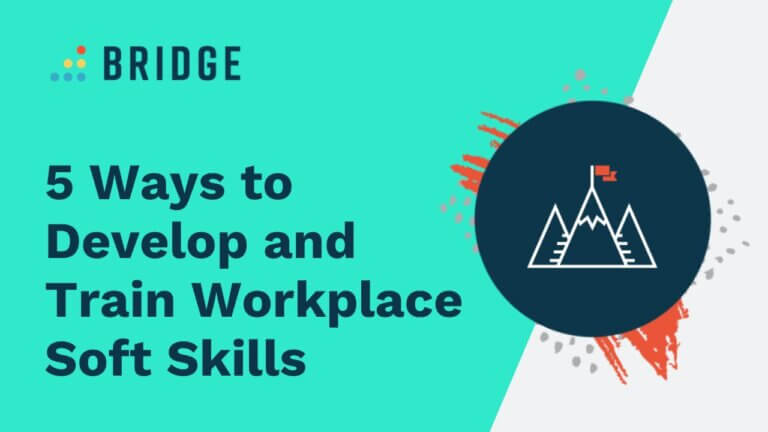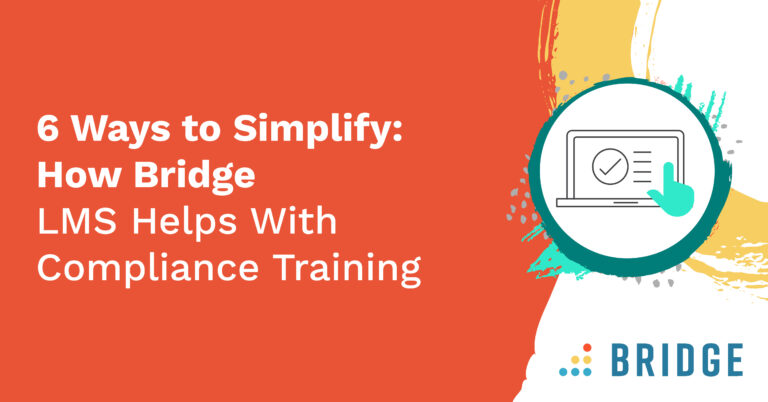Against the backdrop of increasingly turbulent cultural and technological change, organizations can’t deny the importance of fostering talent and human capability. A training and development strategy is essential for long-term growth and sustained success when, according to PwC survey data, 85% of CEOs reported critical skills shortages in 2022.
Leaders are discovering that not only are digital skills lacking, but core soft skills such as teamwork, leadership, relationship-building, and communication skills are in short supply.
The shift toward remote and hybrid working, coupled with the rapid evolution of technologies and practices, has highlighted the need for adaptability, communication, and empathy.
The Need for Employee Soft Skills Development
If recent events have taught us anything, upheaval, and transformation are the new realities. Navigating a world defined by rapid change has left many businesses with the need to rethink how they attract, retain, and develop employees.
LinkedIn’s Workplace Learning Report shows that the skills required for a job changed by 25% between 2015 and 2023. By 2027, the number is expected to double.
In a landscape of rapid change and disruption, it’s critical that employees have adaptable and relevant human skills, and nearly 90% of L&D professionals agree that proactively building skills will help organizations navigate the future.
The top most in-demand soft skills reported are:
- Management
- Communication
- Leadership
- Teamwork
THE SKILLS YOUR PEOPLE NEED TO THRIVE | ‘New Year, New Skill Sets: Predicting the In-Demand Skills for 2023 (And Beyond!)’
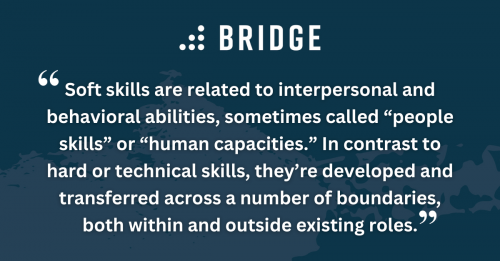
Soft Skills Versus Hard Skills: How to Define and Measure
According to research by Deloitte, although the majority of employers are increasingly looking to soft skills and behaviors to futureproof the workforce, 83% still value hard skills such as experience and degrees.
To effectively respond to demand and remain successful, organizations must evaluate how they define, develop, and deploy skills.
What Are Hard Skills?
Think about hard skills as the traditional, role-based skills that people actively learn and develop to perform a specific duty. Developing these abilities and competencies shows that an employee has the knowledge, experience, and abilities to perform a job or role.
Hard or technical skills can be easily measured and quantified with statistics, yes/no results, or by earning a credential.
Examples of hard skills include:
- Web development
- Electrical engineering
- Data analysis
- Business development
- Bookkeeping
What Are Soft Skills?
Soft skills are related to interpersonal and behavioral abilities, sometimes called “people skills” or “human capacities.” In contrast to hard or technical skills, they’re developed and transferred across a number of boundaries, both within and outside existing roles that aren’t usually associated with a specific job or occupation.
These skills can be applied to a number of different situations and used to strengthen interactions, adapt to challenges, and help people navigate in their professional environments.
Quantitative methods such as employee engagement surveys, performance reviews, or 360 feedback can capture engagement, satisfaction, and productivity that result from well-developed soft skills.
Examples of soft skills include:
- Effective communication
- Organization and time management
- Empathy
- Adaptability and flexibility
- Teamwork
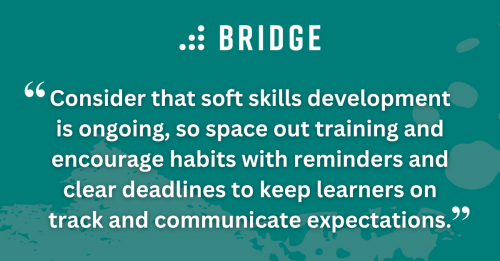
TRANSFORM YOUR TALENT WITH SKILLS DEVELOPMENT | ‘How Talent Mobility Empowers Employee Development’
5 Ways to Develop Soft Skills in the Workplace
Developing employees’ soft skills can add an enormous amount of value to your organization. An effective L&D strategy should align organizational needs with employee goals to forecast for the future and develop the areas where these talents will add the most impact through learning, practice, and application.
1) Create Personalized Learning Pathways to Reinforce Behaviors
Map out the skills your organization needs and those your people want to develop, then create learning pathways to guide learners to their goals. By paving each step with relevant, engaging content, practice activities, and skills feedback, you encourage a continuous momentum of learning, developing, and application in small bursts. This way, learning feels natural, giving your people opportunities to seamlessly develop soft skills in the flow of work.
Scenario-based videos and user content created by peers that show skills and behaviors in action can expose learners to various situations and refine abilities such as problem-solving, conflict resolution, and communication. When this training is coupled with action-based steps like assignments, quizzes, and role-play scenarios, you allow learners to practice in a safe space and see their progress in real-time.
To strengthen behaviors over time, consider roleplay scenarios, webinars, or feedback surveys to self-evaluate progress. Consider that soft skills development is ongoing, so space out training and encourage habits with reminders and clear deadlines to keep learners on track and communicate expectations.
HOW TO CREATE EFFECTIVE PLANS | ‘4 Steps to Create an Employee Development Plan’
2) Lead By Example
Your leaders have an enormous influence on productivity and company culture. In a survey of HR leaders, 90% say that the future success of their company requires leaders to display human-centric qualities, act with authenticity and empathy, and be adaptable to unique needs. Three-quarters of employees also believe that a culture of connectedness is important for them to be effective in their jobs.
To create a productive workplace based on connection and alignment of goals, leaders, and managers need opportunities to practice and refine communication, empathy, and listening skills. Existing leaders must practice and refine interpersonal skills, adapt based on individual needs, and be willing to learn from others.
A strong training program should develop people-first leadership skills at all levels of the organization, with a focus on both traditional and experiential learning methods. This blended approach means current leaders and managers can practice their skills, and future talent can learn the skills needed to step into roles with experience and confidence.
For future leaders, on-the-job training opportunities such as project management or mentoring peers are great ways to practice soft skills and behaviors that can also benefit them in their current roles.
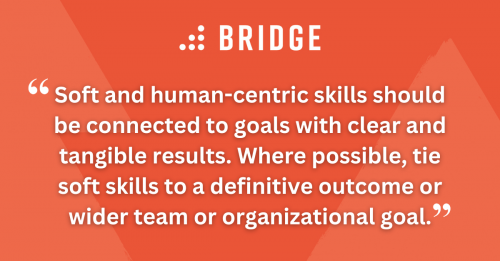
LEADERSHIP DEVELOPMENT MUST-HAVES | ‘How to Develop People-First Leaders’
3) Offer Coaching, Mentoring, and Skills Feedback Opportunities
Coaching, mentoring, and opportunities for skills feedback can be effective when used alongside other development activities. By creating communities of learners based on shared skills, behaviors, and talents, people can connect with others who possess the skills they want to develop.
This opens doors to more personalized development opportunities where peers can act as coaches, watch learners practice to assess current performance, and provide actionable and relevant feedback they can apply going forward.
To make the most of real-world practice, conversations and meetings should be scheduled strategically. By setting a regular cadence for skills reviews and performance conversations, or otherwise scheduling such check-ins after a learner has completed a project, they’ll gain a deeper understanding of where they’ve improved, how their skills and behaviors benefit others, and how this feeds into wider team and business goals.
3 WAYS TO ENHANCE L&D PROGRAMS WITH FEEDBACK | ‘Next Steps With Bridge Journeys: 3 New Features That Take Your Learners Further’
4) Encourage Ongoing Knowledge Sharing and Collaboration to Connect the Hybrid Workforce
As remote and hybrid work becomes the norm, many leaders fear a decline in employee social skills, such as negotiation, networking, and public speaking. Employees agree, according to Gartner research—the data shows that 51% entering the workforce don’t believe their education prepared them with the social skills needed.
While connecting via digital platforms has changed how workers interact and collaborate, asynchronous methods can aid and develop teamwork, communication, and problem-solving skills.
Look for a learning platform that facilitates connection through webinars, workshops, and live training sessions, encouraging teamwork and participation as learners share ideas. Similarly, creating cohorts of learners who can share knowledge, feed into projects, and support one another can boost teamwork.
Organizations should foster knowledge sharing at all levels to encourage people to learn from each other. An online resource library that people can learn from and contribute to builds connections and strengthens culture.
CREATE A CULTURE OF CONVERSATION | ‘3 Employee Engagement Ideas for Remote Workers’
5) Connect Soft Skills to Performance Goals and Objectives
Soft and human-centric skills should be connected to goals with clear and tangible results. Where possible, tie soft skills to a definitive outcome or wider team or organizational goal. According to research by Deloitte, some of the top ways to verify and measure human skills and capabilities include:
- Credentials, certifications, and apprenticeships (58%)
- Peer or manager feedback, assessments, or endorsements of skills (55%)
- Digital assessments such as simulations, challenges, and assessments (46%)
Alongside assessments and training, measures such as skills feedback, engagement scores, and employee retention are all effective indicators. When creating development plans, employees and managers should define the expected outcome of training. Then they can establish clear performance goals to assess the impact and measure how successfully employees apply soft skills.
Learners should engage in ongoing performance conversations with managers and be allowed to reflect on their progress, discuss any obstacles, and refocus on goals. It’s helpful for managers to look at the metrics and support employees working toward development goals with personalized recommendations that match their strengths and offer opportunities for improvement.
ACTIONABLE WAYS TO ALIGN TRAINING GOALS | ‘Get Aligned: 3 Ways to Keep Employees Aligned With Organizational Goals’
Give Your People The Skills They Need With Bridge
Keep your learners’ skill sets sharp with Bridge’s learning management system (LMS). Deliver engaging soft skills training, connect coworkers to learn and share knowledge, and foster a culture of ongoing learning and reflection to refine knowledge and behaviors.
Conduct skills assessments to find the most in-demand skills, create targeted learning pathways that encourage continuous development, and tie training to performance goals to measure the impact.
